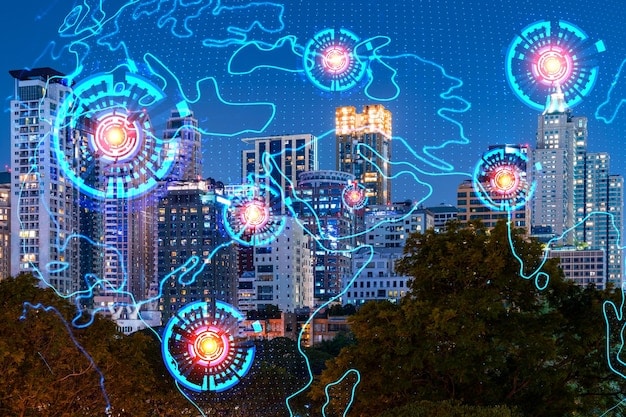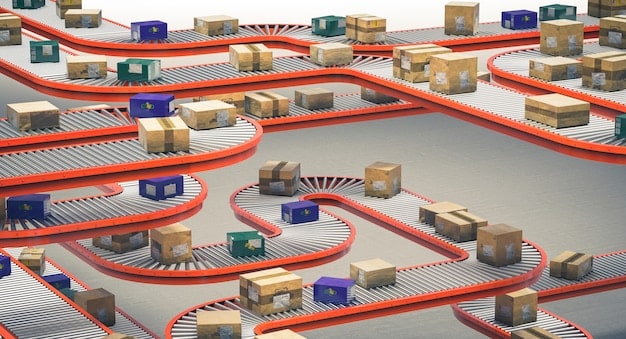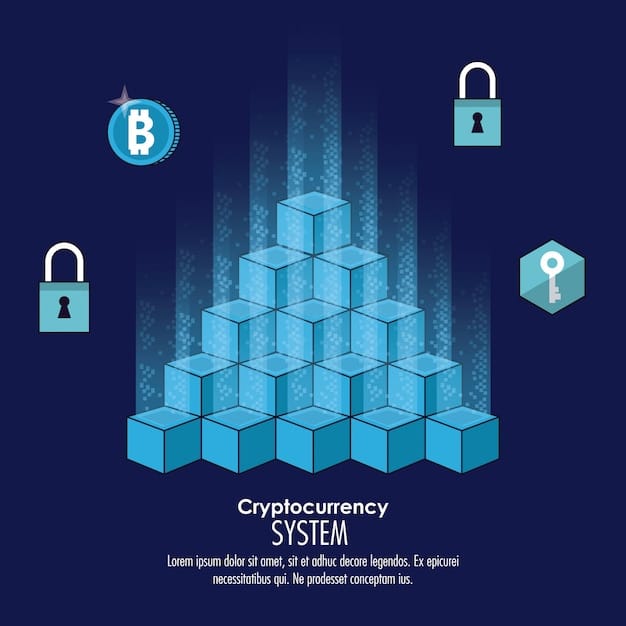Blockchain Beyond Crypto: Real-World Applications & Future Uses

Blockchain technology extends far beyond cryptocurrencies, offering secure and transparent solutions in supply chain management, healthcare, voting systems, digital identity, and more, revolutionizing various industries.
The buzz around blockchain often centers on Bitcoin and other cryptocurrencies. But the potential of blockchain technology: what are the real-world applications beyond cryptocurrency? is vast and transformative, reaching far beyond the realm of digital currencies.
Understanding Blockchain Technology Beyond Cryptocurrency
While often associated with cryptocurrencies, the fundamental concept of blockchain technology is much broader. It’s a distributed, decentralized, public ledger that records transactions across many computers.
This creates a secure and transparent system, making it ideal for a variety of applications where trust and immutability are crucial.
Key Features of Blockchain
To truly understand the real-world applications, it’s essential to grasp the core features that define blockchain technology.
- Decentralization: Data is not stored in a single location, making it resistant to censorship and single points of failure.
- Transparency: All transactions are publicly visible on the blockchain, fostering trust and accountability.
- Immutability: Once a transaction is recorded, it cannot be altered or deleted, ensuring data integrity.
- Security: Cryptographic techniques secure the blockchain, making it extremely difficult to tamper with the data.
These features combine to create a technology that can revolutionize how we manage data, conduct transactions, and build trust in various processes.
In conclusion, blockchain is not just for cryptocurrencies; its core properties provide a strong foundation for secure, transparent, and efficient systems across many different sectors.
Supply Chain Management: Enhancing Transparency and Traceability
One of the most promising applications of blockchain technology lies in supply chain management. Many companies suffer with intricate networks, product provenance, and a lack of transparency.
Blockchain offers a solution by providing an immutable record of a product’s journey from origin to consumer.
Tracking Products with Blockchain
By tracking products on a blockchain, businesses can gain greater visibility into their supply chains, improve efficiency, and reduce the risk of fraud.
- Verifying Authenticity: Consumers can verify the authenticity of products, ensuring they are not counterfeit.
- Improving Traceability: Businesses can quickly trace the origin of products, enabling faster recalls and improved food safety.
- Reducing Costs: Automation and increased transparency can reduce administrative costs and improve overall efficiency.

Several companies are already implementing blockchain in their supply chains. For example, Walmart uses blockchain to track the origin of its mangoes, reducing the time it takes to trace a contaminated batch from weeks to seconds.
In brief, by increasing transparency and traceability, blockchain could transform global supply chains, making supply chains faster, more secure and trustworthy.
Healthcare: Securing Patient Data and Improving Interoperability
The healthcare industry faces significant challenges in securing patient data and ensuring interoperability between different systems. The protection of data is paramount.
Blockchain technology: what are the real-world applications beyond cryptocurrency? can provide a secure and decentralized platform for managing patient records and facilitating data sharing.
Benefits of Blockchain in Healthcare
Blockchain offers several potential benefits for the healthcare industry, addressing key pain points and improving patient care.
- Secure Data Storage: Patient records can be stored securely on a blockchain, protected from unauthorized access and tampering.
- Improved Interoperability: Blockchain can facilitate data sharing between different healthcare providers, enabling better coordination of care.
- Enhanced Data Integrity: The immutability of blockchain ensures the integrity of patient data, reducing the risk of errors and fraud.
One example of blockchain’s use in healthcare is in managing clinical trial data. By storing trial data on a blockchain, researchers can ensure the integrity and transparency of their findings.
Essentially, blockchain can transform healthcare by making it possible for the patient to be more in control of their own data and making it possible to securely store, access, and share health records.
Voting Systems: Enhancing Security and Transparency
The integrity of voting systems is critical for democracy. Traditional voting systems are often vulnerable to fraud and manipulation. The integrity of the system is incredibly important.
Blockchain technology offers a potential solution by providing a secure and transparent platform for casting and counting votes.
How Blockchain Can Secure Elections
Blockchain can address many of the security and transparency challenges associated with traditional voting systems.
- Immutable Record: Each vote is recorded as a transaction on the blockchain, creating an immutable record that cannot be altered.
- Transparency: The voting process is transparent, allowing voters to verify that their votes were accurately recorded.
- Accessibility: Blockchain-based voting systems can be more accessible, allowing voters to cast their votes from anywhere in the world.

While blockchain-based voting systems are still in their early stages of development, several pilot projects have been conducted around the world. These projects have demonstrated the potential of blockchain to enhance the security and transparency of elections.
In summary, although still in its early stages, blockchain has the potential to make it more secure and verifiable for individuals to cast their votes.
Digital Identity: Empowering Individuals with Control Over Their Data
Managing digital identities is an increasingly complex challenge. Individuals often have multiple online identities, and their personal data is scattered across various platforms.
Blockchain provides a framework for individuals to take control of their digital identities, storing their personal data in a secure and decentralized manner.
Benefits of Blockchain-Based Digital Identity
A blockchain-based digital identity system offers several advantages over traditional identity management solutions. Here are some of the advantages.
One approach to blockchain, built with identity controls, is called “self-sovereign identity (SSI)”.
- Data Ownership: Individuals own and control their personal data, deciding who has access to it.
- Enhanced Security: Personal data is stored securely on a blockchain, protected from unauthorized access and identity theft.
- Streamlined Processes: Individuals can use their blockchain-based digital identities to access various services, simplifying online interactions.
Several organizations are working on developing blockchain-based digital identity solutions. These solutions have the potential to transform how people manage their online identities and interact with online services.
To summarize, blockchain has the promise to greatly improve how individuals manage their identities online, providing them with ultimate power over their data.
Smart Contracts: Automating Agreements and Building Trust
Smart contracts are self-executing contracts written in code and stored on a blockchain. They automatically enforce the terms of an agreement when certain conditions are met.
This automation and transparency can reduce the need for intermediaries and build trust between parties.
Applications of Smart Contracts
Smart contracts have a wide range of applications across various industries.
- Financial Services: Automating payments, escrow services, and insurance claims.
- Real Estate: Streamlining property transfers and managing rental agreements.
- Supply Chain: Automating payments and tracking goods throughout the supply chain.
One example of a smart contract application is in the insurance industry. Smart contracts can be used to automatically process insurance claims when certain conditions are met, such as a flight delay or a natural disaster.
Overall, smart contracts are important to blockchain, creating new and inventive methods to create and enforce agreements in nearly every sector.
Challenges and Future of Blockchain Technology
While blockchain technology offers numerous benefits, it also faces several challenges that need to be addressed before it reaches widespread adoption. Every technology faces challenges.
Scalability, regulation, and public perception are among the key obstacles.
Overcoming the Hurdles
Addressing these challenges is crucial for unlocking the full potential of blockchain technology. Here are some challenges for consideration.
One of the main challenges is scalability. Many blockchain networks can only process a limited number of transactions per second, which can be a bottleneck for applications that require high throughput.
Another challenge is regulation. The legal and regulatory landscape for blockchain technology is still evolving, which creates uncertainty for businesses and investors.
Finally, the public perception of blockchain is often negative, due to its association with cryptocurrencies and illicit activities. Building trust and educating the public about the potential benefits of blockchain is essential for its widespread adoption.
With this in mind, there will be future applications and growth of blockchain technology as it continues to be developed and improved upon.
| Key Point | Brief Description |
|---|---|
| 📦 Supply Chain | Enhances transparency and traceability of products. |
| ⚕️ Healthcare | Secures patient data and improves system interoperability. |
| 🗳️ Voting | Enhances security and transparency of electoral processes. |
| 🔑 Digital Identity | Empowers individuals with control over their personal data. |
Blockchain FAQ
▼
The primary benefit is enhanced transparency and traceability, allowing businesses and consumers to verify the authenticity and origin of products quickly and efficiently.
▼
Blockchain secures patient data by storing it in a decentralized, immutable ledger, which prevents unauthorized access and tampering, thus ensuring data integrity.
▼
Yes, blockchain can enhance voting security by creating an immutable record of each vote, making the voting process transparent and verifiable, which helps prevent fraud.
▼
Self-sovereign identity (SSI) empowers individuals to own and control their digital identities, deciding who has access to their personal data stored on a blockchain.
▼
Smart contracts are self-executing contracts stored on a blockchain. They automatically enforce the terms of an agreement when predefined conditions are met, reducing the need for intermediaries.
Conclusion
In conclusion, blockchain technology’s transformative potential extends far beyond cryptocurrencies. Its applications in supply chain management, healthcare, voting systems, digital identity, and smart contracts are revolutionizing industries by enhancing security, transparency, and trust. As the technology continues to evolve and overcome challenges, its impact on the real world will only continue to grow.





